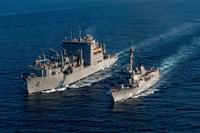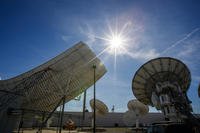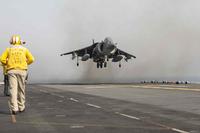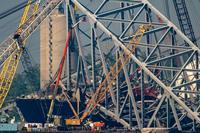OKINAWA, Japan — The Deputy Commandant of Marine Corps Installations and Logistics, Lt. Gen. Michael G. Dana, visited Marine Corps Base Camp Butler Nov. 5.
The visit allowed Dana to observe the strategic resources and high readiness of Marine Corps Installations Pacific camps and facilities in daily support of operations across the Indo-Asia-Pacific region. It also drew attention to the importance of financial and manpower resources within MCIPAC.
The tour began on Camp Courtney, where Dana joined senior leadership from commands on Okinawa for an air tour of the strategic locations on Okinawa aboard a UH-1Y Huey helicopter.
Among the leadership who accompanied Dana were Brig. Gen. Tracey W. King, commanding general of the 3rd Marine Logistics Group, III Marine Expeditionary Force, and Col. Christopher B. Snyder, deputy commander of Marine Corps Installations Pacific, who discussed the strategic access and capabilities of Marine Corps assets on Okinawa.
"The visit gave Lt. Gen. Dana the opportunity to see the key units on Okinawa," said Snyder. "The location of Okinawa in and of itself is strategic, as we send aid to many countries in the Indo-Asia Pacific. Some of the places we are flying over today, whether they are Naha Military Port, White Beach or the Tengan Pier, all represent the strategic access points we have which support III MEF."
The most recent example of MCIPAC support for a real-world operation was in May, as Marines and equipment from the strategically-located bases in Okinawa flew to Nepal to assist after the devastating 7.8 earthquake.
The air tour ended on Marine Corps Air Station Futenma, where the officials disembarked at the 1st Marine Aircraft Wing headquarters building.
"Proximity is everything," said Dana. "The Port of Naha, and all of the different places we flew over, present some of the strongest and best places to do what we do here in the Pacific."
Dana, Snyder and several other officials filed into the headquarters building conference room, where Col. Peter Lee, the commanding officer of MCAS Futenma, gave a brief highlighting the logistics and operational assets and capabilities of the air station.
According to Lee, MCAS Futenma is undergoing many renovations and restorations. The air station provides many operational capabilities with a relatively small geographic footprint.
Lee also explained the logistics behind the Futenma work and how funding and manpower are being utilized in order to best ensure mission completion.
When Lee concluded the brief, the officials boarded a bus for a windshield tour of the air station.
"I was stationed on Okinawa many years ago, and it is good to see the improvements that are being made here," said Dana. "In this brief period of time, I have seen vast improvements, and it is really encouraging to see the ambition and good work of military personnel and the Japanese work force."
After concluding the tour of MCAS Futenma, the officials transitioned to the MCIPAC Headquarters building aboard Camp Foster to discuss future land return sites, relocation plans and other key factors affecting MCIPAC, followed by a tour of Camp Foster's facilities.
"Given the key support role MCIPAC plays, these facilities are especially important," said Dana. "MCIPAC provides command headquarters, training platforms and places for Marines in the Pacific to live and work. The command adjudicates the money and resources to take care of Marines and their training."
During the facilities tour, staff members from the Kadena Housing Office and the 18th Civil Engineer Group, 18th Wing, from Kadena Air Base, gave a presentation on base housing provision and upcoming renovations. After the tour, the officials returned to the MCIPAC Headquarters Building and stepped off for a fellowship dinner.
"MCIPAC provides bases and airfield support to six different commands across the Pacific, in Hawaii, mainland Japan, Okinawa and Korea," said Snyder. "This is what gives the Marine Corps the forward-deploying capability so III Marine Expeditionary Force Marines can come in, train in these locations and launch off to complete missions whether they be humanitarian assistance, disaster relief or combat operations. This way, we can stand ready when the call comes."
Related video:



























